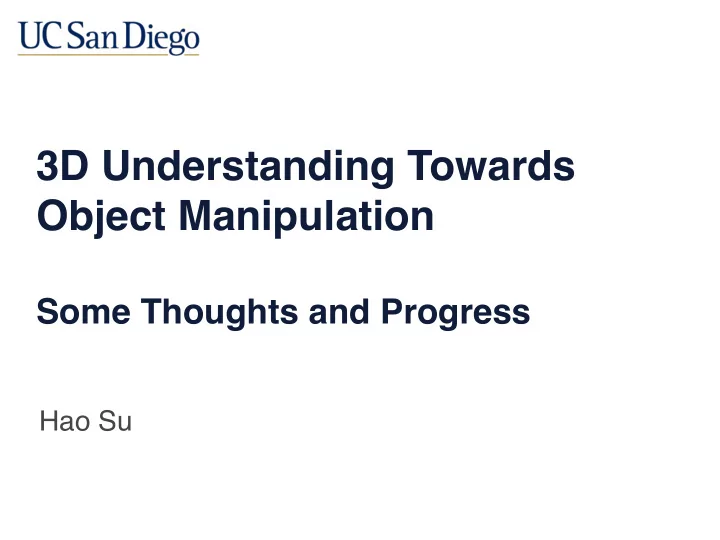

High-level Idea • Sim2Real+Imitation Learning (Search+NN) • For objects in training data • sample grasps (gripper pose) • verify by force closure (using full geometry) • record good ones on the shape surface (grasp pose function defined on the surface) • Simulate partial scan of objects in the training data • Use neural network to learn the grasp pose function from partial scans
Search For Object-Centric Grasps • Enumerate possible grasps based on local geometry around contact points Classical: Daboux Frame Ours
Search For Object-Centric Grasps • Verify by force-closure (can resist external forces)
Good Grasps as Surface Function Regression grasp pose precisely is hard globally • The size of arena: 1.5m • However, 1.5 cm (1%) error is large enough for failure • Solution: regress local poses • In dataset, register each grasp with nearest point • Predict local offset with respect to this point
Scene-level Considerations • Collision checking with the whole scene • Render depth from different views as input for network
Single-shot Grasp Proposal • Input: single-view observation • Output: grasp poses and corresponding quality scores
PointNet++: Extract Hierarchical Features Local features: • How to grasp the object Global features: • Avoid collision with other object
Quantitative Result Outperform other SOTA methods with large margin in accuracy and efficiency
Discussion • Main error source • Low depth map quality (precision+completeness) Cheap and high-quality 3D sensor is vital • Sim2Real: • Model trained on sim directly applied on real: • RGB information is not used in this work Point Cloud representation: lower domain gap
So far, Purely Mechanics-based • Exploratory robot should use manipulation as a mean to verify structure hypothesis of objects Source: Eckovation
Sampled Research Work (III) Structure Hypothesis Generation: Zero-shot 3D Part Proposal Learning to Group: A Bottom-Up Framework for 3D Part Discovery in Unseen Categories, Luo et al. ICLR 2020
Structured Environment Virtual Model Sensing Analyze Knowledge Base
Task New Data Data in Knowledge Base Training set and test set are of different categories, but reuse local structures
Why Few-shot/Zero-shot Learning in 3D? Algorithmically, 3D shapes are: • easier to be related (correspondence) • easier to be compared • easier to abstracted
Revisit 3D Part Segmentation • Learning-Based Methods • Fully Convolutional [PartNet-InsSeg, Mo et al.] • Clustering Based [SGPN, Wang et al.] • Segmentation by Synthesis [GSPN, Yi et al.] Train on chair, storage furniture and lamp, Test on faucet Fully Conv Clustering Seg by Synth Reference
Revisit 3D Part Segmentation • Traditional Methods • Use part geometry heuristics • convexity, flatness, etc [WCSeg, Kaick et al.] Train on chair, storage furniture and lamp, Test on faucet Fully Conv Clustering Seg by Synth Reference Traditional
Key Idea Incorporating global context is likely to hurt zero-shot generalization. Should be parsimonious in using context information.
Our Approach Sub-Part Pool
Our Approach Sub-Part Pool Policy Module
Our Approach Sub-Part Pool Policy Verification Module Module
Our Approach Sub-Part Pool If False Policy Verification Module Module
Our Approach Sub-Part Pool If False Policy Verification Module Module
Our Approach Sub-Part Pool If False Policy Verification Module Module
Our Approach Sub-Part Pool If True Policy Verification Module Module
Our Approach Sub-Part Pool If True Policy Verification Module Module
Our Approach Sub-Part Pool If True Policy Verification Module Module Final
Qualitative Results Train on chair, storage furniture, and lamp. Test on bed and faucet, respectively.
Quantitative Results Train on chair, storage furniture, and lamp. Test on both seen categories and unseen categories. Number is the average recall.
Sampled Research Work (IV) Environment For End-to-End Learning & Evaluation of Interaction Tasks SAPIEN: A SimulAted Part-based Interactive ENvironment, Xiang et al. CVPR 2020 (oral)
An Accessible Platform to Explore Object Manipulation Problems • Real robot/experiments are costly • When it comes robotics planning/execution • Time: cannot speed up real-world physics • Cost: costly to maintain hardware • Hardware stability: hard to reproduce experiments • Safety • Alternative: Simulation
SAPIEN Xiang et al., “ SAPIEN: A SimulAted Part-based Interactive ENvironment ”, CVPR 2020
SAPIEN System
SAPIEN Xiang et al., “ SAPIEN: A SimulAted Part-based Interactive ENvironment ”, CVPR 2020
Recommend
More recommend